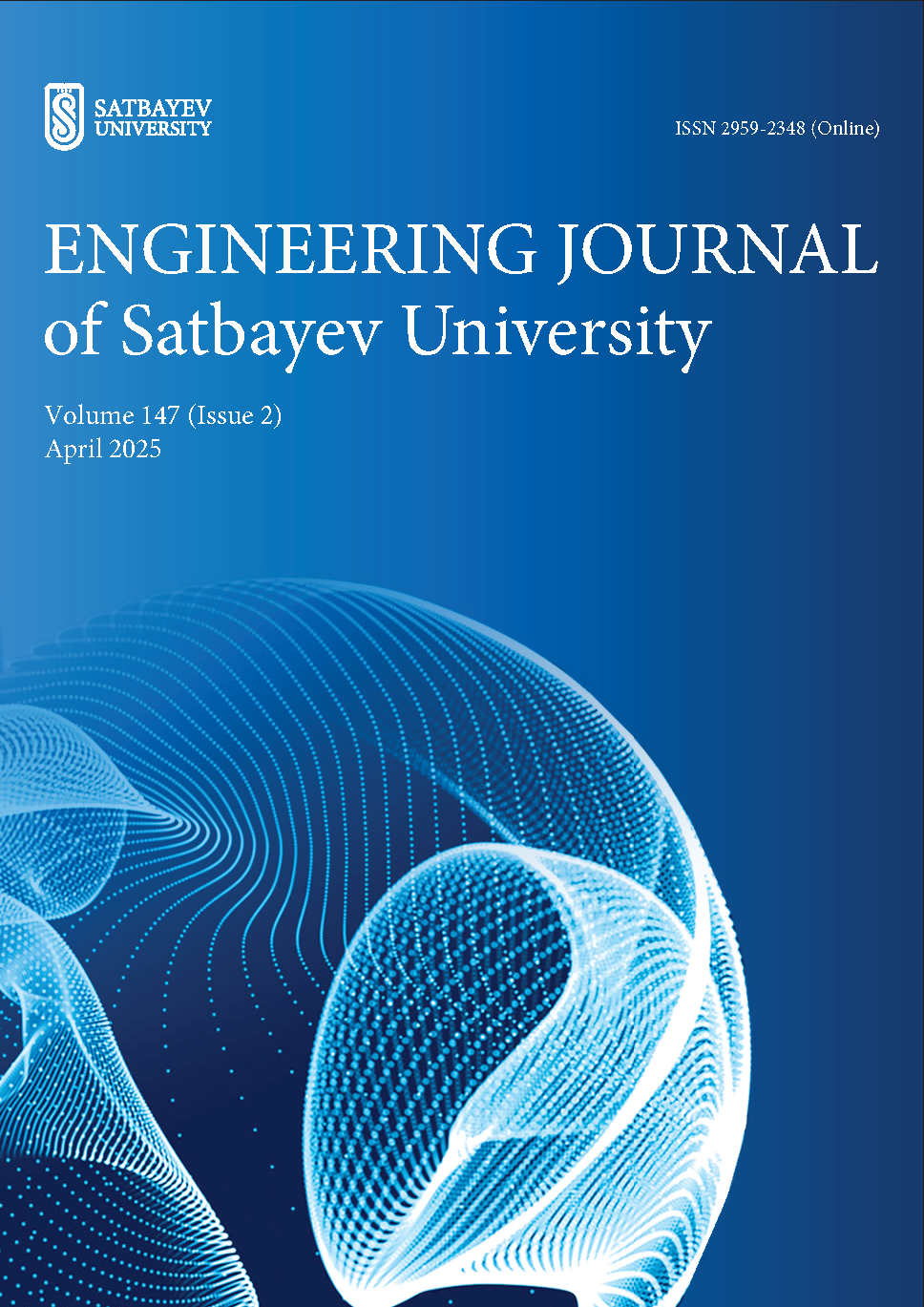Сравнительный анализ состояния опустынивания земель Западного и Восточного Казахстана
DOI:
https://doi.org/10.51301/ejsu.2025.i2.06Ключевые слова:
опустынивание, климат, температура, влажность, осадки, дистанционное зондирование, мониторингАннотация
В исследовании проводится анализ и сравнение двух совершенно разных, но в некоторых случаях схожих регионов Западного и Восточного Казахстана. На примере Западного и Восточного Казахстана описано влияние изменений климатических данных, структуры почвы и ее чувствительности на процесс опустынивания в Казахстане за десятилетия 2000-х, 2010-х годов и с 2020 по 2024 год. Автор сравнил и обнаружил, что типы почв: Zg, XI, So, WR и KI встречаются как на Западе, так и на Востоке Казахстана, подверженных деградации почвенной структуры. Климатические параметры, такие как температура воздуха в данной местности, фиксированно колеблются в пределах 3.6-4.9°С, влажность существенно меняется, все время в пределах 64%-77%, а количество осадков в разные периоды времени менялось от 416 мм до 605 мм. Используя данные дистанционного зондирования, автор проанализировал изменения в природной среде, создал визуализации и 3D-моделирование в процессе мониторинга. Таким образом, был представлен набор существующих исследовательских работ, статистическая информация и собственный опыт, поскольку в ходе работы были представлены результаты научных исследований по опустыниванию. Результаты исследования показали, что в Казахстане наблюдается ускоренный процесс опустынивания земель.
Библиографические ссылки
Jiang, L., Bao, A., Jiapaer, G., Guo, H., Zheng, G., Gafforov, K., Kurban, A. & De Maeyer, P. (2019). Monitoring land sensi-tivity to desertification in Central Asia: Convergence or diver-gence. Science of the Total Environment, (658), 669-683. https://doi.org/10.1016/j.scitotenv.2018.12.152
Shao, H., Liu, M., Shao, Q., Sun, X., Wu, J., Xiang, Z. & Yang, W. (2014). Research on eco-environmental vulnerability evaluation of the anning River Basin in the upper reaches of the Yangtze river. Environmental Earth Sciences, 72(5), 1555-1568. https://doi.org/10.1007/s12665-014-3060-9
Government website. (2024). About Kazakhstan. Administrative and territorial structure. Retrieved from: https://www.gov.kz/article/19305?lang=en
Assanova, M.A. (2015). Public policy and model of sustainable development in the re-public of Kazakhstan. Asian Social Sci-ence, 11(6), 237-243. https://doi.org/10.5539/ass.v11n6p237
Saigal Kazakhstan. (2015). Issues and approaches to Combat Desertification 2005-2015. Retrieved from: https://www.unccd.int/sites/default/files/naps/kazakstan-eng2005.pdf
Baitulin, I.O. (2001). National Strategy and Action Plan to Combat Desertification in Kazakhstan, Sustainable Land Use in Deserts. Springer, Berlin, Heidelberg. https://doi.org/10.1007/978-3-642-59560-8_47
Symeonakis, E., Karathanasis, N., Koukoulas, S. & Panagopou-los, G. (2016). Monitoring sensitivity to land degradation and desertification with the environmentally sensitive area index: the case of Lesvos Island. Island Degrad. Dev., 27(6), 1562-1573. https://doi.org/10.1002/ldr.2285
Veron, S.R., Paruelo, J.M. & Oesterheld, M. (2006). Assessing desertification. Journal of Arid Environments, 66(4), 751-763. https://doi.org/10.1016/j.jaridenv.2006.01.021
Liu, J., Wang, Y., Peng, J., Braimoh, A.K. & Yin, H. (2013). Assessing vulnerability to drought based on exposure, sensitivi-ty and adaptive capacity: a case study in middle Inner Mongolia of China. Chinese Geographical Science, 23 (1), 13-25. https://doi.org/10.1007/s11769-012-0583-4
Popov, M.G. (2011). Vegetation of Kazakhstan. Part 2. Re-trieved from: https://otherreferats.allbest.ru/geography/00008737_0.html
Amirkhanov, M.E. & Zhakypbek, Y. (2023). Remote sensing monitoring of desertification in the Kurchum district of east Ka-zakhstan region. International journal Young Scientist, 1.1 (448.1), 13–17
Saparov, A.S. (2013). Soil Research in Kazakhstan. Annual report. Retrieved from: https://www.fao.org/fileadmin/user_
upload/GSP/docs/eurasian_workshop/Soils_of_Russiaba.pdf
Zhumabayev, E.E. (2015). Strategic measures to combat deserti-fication in the Republic of Kazakhstan until 2025. Retrieved from: https://ecogosfond.kz/wp-content/uploads/2018/06/opus
tinivanie.pdf
Mamyrkhanova, M. (2022). How the East Kazakhstan region will be divided. Retrieved from: https://ru.sputnik.kz/20240117/rf-i-kazakhstan-dogovorilis-ob-uvelichenii-obema-tranzita-nefti-v-knr-do-10-mln-tonn-v-god-41642222.html
Oskemen Annual Weather Averages. (2017). Monthly Average High and Low Temperature. Average Precipitation and Rainfall days. Retrieved from: https://www.worldweatheronline.com/
Oskemen-weather-averages/East-Kazakhstan/KZ.aspx
Government website. (2024). Committee for construction and housing and communal services of the Ministry of investment and development of the Republic of Kazakhstan. Construction climatology of the Republic of Kazakhstan. Retrieved from: https://www.gov.kz/memleket/entities/kds?lang=en
Robinove, C.J., Chavez, P.S., Gehring, D. & Holmgren, R. (2021). Arid land monitoring using Landsat albedo difference images. Remote Sensing of Environment, (11), 133-156. https://doi.org/10.1016/0034-4257(81)90014-6
Sun, Q.Q., Zhang, P. Sun, D.F. Liu, A.X. & Dai, J.W. (2018). Desert vegetation-habitat complexes mapping using Gaofen-1 WFV (wide field of view) time series images in Minqin County. China. International Journal of Applied Earth Observation and Geoinformation, (73), 522–534. https://doi.org/10.1016/j.jag.2018.07.021
Amirkhanov, M., Zhakypbek, Y., Aben, A. & Mussakhan, N. (2023). Monitoring of glaciation and melting in the east Kazakhstan region. Almaty. Mining journal of Kazakhstan, (11), 27-30.
Ehleringer, J.R. (2021). Leaf absorptances of Mohave and Son-oran Desert plants. Oecologia, (49), 366-370. https://doi.org/10.1007/BF00347600
Republican State Enterprise Kazhydromet. (2023). An overview of the climate features in Kazakhstan. Retrieved from: https://www.kazhydromet.kz/uploads/calendar/192/year_file/6646ff553af2710-05-2024_obzor-osobennostey-klimata_kazahstan-za-2023.pdf
Загрузки
Опубликован
Как цитировать
Выпуск
Раздел
Лицензия
Copyright (c) 2025 Engineering Journal of Satbayev University

Это произведение доступно по лицензии Creative Commons «Attribution-NonCommercial-NoDerivatives» («Атрибуция — Некоммерческое использование — Без производных произведений») 4.0 Всемирная.
<div class="pkpfooter-son">
<a rel="license" href="http://creativecommons.org/licenses/by-nc/4.0/"><img alt="Creative Commons License" style="border-width:0" src="https://i.creativecommons.org/l/by-nc/4.0/80x15.png"></a><br>This work is licensed under a <a rel="license" href="http://creativecommons.org/licenses/by-nc/4.0/">Creative Commons Attribution-NonCommercial 4.0 International License</a>.
</div>





